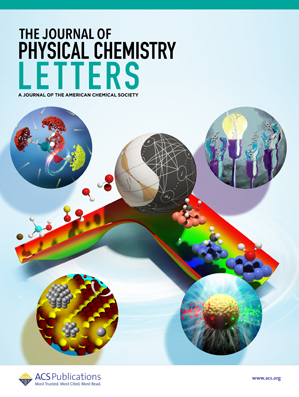Quantifying Design Principles for Light-Emitting Materials with Inverted Singlet–Triplet Energy Gaps
IF 4.8
2区 化学
Q2 CHEMISTRY, PHYSICAL
引用次数: 0
Abstract
Molecular engineering of organic emitter molecules with inverted singlet–triplet energy gaps (INVEST) has emerged as a powerful approach for enhancing fluorescence efficiency through triplet harvesting. In these unique materials, the first excited singlet state (S1) lies below the lowest triplet state (T1), enabling efficient reverse intersystem crossing. Previous computational studies have focused on accurately calculating the inverted energy gap and establishing qualitative structure–property relationships. Here, we present quantitative relationships that link the molecular structure to the S1–T1 energy gap, ΔEST, by introducing a benchmark set of 15 heptazine-based INVEST molecules (HEPTA-INVEST15). We identify a strong linear correlation (R2 > 0.94) between ΔEST and both the degree of intramolecular charge transfer and the deviation from a single-excitation character, as quantified by %R1 values and transition density matrix norms. These trends persist across our expanded set of 44 mono-, di-, and tri-substituted heptazines (HEPTA-INVEST44), underscoring the generality of our findings. Notably, strongly electron-donating groups, such as −NH2, minimize the magnitude of inverted gaps in mono-substituted heptazines yet produce the most negative ΔEST in certain tri-substituted derivatives, a result arising from competing resonance effects and excited-state aromaticity. Although ΔEST shows no clear correlation with Hammett parameters, our results reveal that physically meaningful, computable descriptors offer a mechanistic foundation for the future data-driven design of INVEST emitters. These findings pave the way for machine-learning approaches that connect the molecular structure to ΔEST without requiring high-level excited-state calculations.

具有反向单重态-三重态能隙的发光材料的量化设计原则
具有反向单三重态能隙(INVEST)的有机发射器分子的分子工程已经成为通过三重态收集来提高荧光效率的有力方法。在这些独特的材料中,第一激发单重态(S1)低于最低三重态(T1),从而实现了有效的反向系统间交叉。以往的计算研究主要集中在精确计算倒能隙和建立定性的构性关系。在这里,我们通过引入15个基于七嗪的INVEST分子(HEPTA-INVEST15)的基准集,提出了分子结构与S1-T1能隙(ΔEST)之间的定量关系。我们发现了很强的线性相关性(R2 >;0.94)与分子内电荷转移程度和偏离单激发特征之间的关系,由%R1值和跃迁密度矩阵范数量化。这些趋势在我们扩大的44个单、二和三取代的七嗪(HEPTA-INVEST44)中持续存在,强调了我们研究结果的普遍性。值得注意的是,强给电子基团,如−NH2,在单取代七嗪中产生最小的反向间隙,而在某些三取代衍生物中产生最负的ΔEST,这是由于共振效应和激发态芳香性的竞争造成的。虽然ΔEST与Hammett参数没有明确的相关性,但我们的研究结果表明,物理上有意义的、可计算的描述符为未来INVEST发射器的数据驱动设计提供了机制基础。这些发现为将分子结构与ΔEST连接起来的机器学习方法铺平了道路,而不需要高水平的激发态计算。
本文章由计算机程序翻译,如有差异,请以英文原文为准。
求助全文
约1分钟内获得全文
求助全文
来源期刊

The Journal of Physical Chemistry Letters
CHEMISTRY, PHYSICAL-NANOSCIENCE & NANOTECHNOLOGY
CiteScore
9.60
自引率
7.00%
发文量
1519
审稿时长
1.6 months
期刊介绍:
The Journal of Physical Chemistry (JPC) Letters is devoted to reporting new and original experimental and theoretical basic research of interest to physical chemists, biophysical chemists, chemical physicists, physicists, material scientists, and engineers. An important criterion for acceptance is that the paper reports a significant scientific advance and/or physical insight such that rapid publication is essential. Two issues of JPC Letters are published each month.
 求助内容:
求助内容: 应助结果提醒方式:
应助结果提醒方式:


